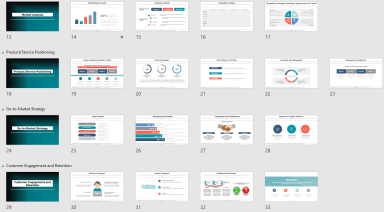
Last version published: 13/02/2024 11:10
Publication number: ELQ-12866-2
View all versions & Certificate

Market Capture Plan Templates
33 Powerpoint Templates to perform standardized research and create Market Capture Plan.
Procedure:
1. Introduction to Market Capture Plan: Understand that a Market Capture Plan outlines strategies and actions to gain a significant share of a target market segment. It aids businesses in positioning their products or services effectively against competitors and capturing the attention and loyalty of potential customers.
2. Define the Objective and Scope:
2.1. Purpose Clarification: Determine the primary goal of the market capture plan, such as entering a new market, increasing market share, or repositioning in an existing market.
2.2. Target Market Definition: Identify and define the specific market segment you aim to capture, considering demographics, geographies, and psychographics.
3. Market Analysis:
3.1. Market Size and Growth: Estimate the potential size and growth rate of the target market segment.
3.2. Customer Analysis: Understand the needs, preferences, and pain points of potential customers in the target segment.
3.3. Competitor Analysis: Identify and analyze key competitors, their strengths, weaknesses, market share, and strategies.
4. Product/Service Positioning:
4.1. Unique Value Proposition (UVP): Define the distinct benefits and features of your product/service that differentiate it from competitors.
4.2. Pricing Strategy: Determine an appropriate pricing model based on market demand, competitor pricing, and your UVP.
4.3. Branding and Messaging: Develop a consistent branding and messaging strategy that resonates with the target audience.
5. Go-to-Market Strategy:
5.1. Sales Channels: Identify the most effective channels for reaching your target audience, such as direct sales, online platforms, or distributors.
5.2. Marketing and Promotion: Plan marketing campaigns, advertising strategies, and promotions to generate awareness and interest.
5.3. Partnerships and Collaborations: Consider forming strategic partnerships or collaborations to leverage complementary strengths and reach a wider audience.
6. Customer Engagement and Retention:
6.1. Customer Support: Establish robust customer support mechanisms to address queries, concerns, and feedback.
6.2. Loyalty Programs: Design programs or incentives to reward repeat customers and encourage referrals.
6.3. Feedback Mechanisms: Implement systems to continuously gather customer feedback and adapt based on insights.
This Best Practice includes
33 powerpoint slides


































